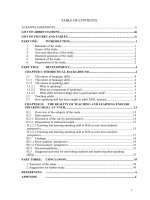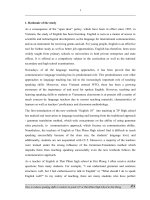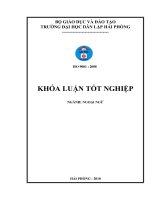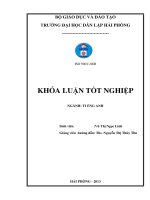Speaking
Bạn đang xem bản rút gọn của tài liệu. Xem và tải ngay bản đầy đủ của tài liệu tại đây (4.71 MB, 9 trang )
<span class='text_page_counter'>(1)</span><div class='page_container' data-page=1>
Lesson Plan: Speaking
<i><b>Lesson: Money</b></i>
<i><b>Class details: 10 first year students.</b></i>
<i><b>Class time: 60 minutes</b></i>
<i><b>Aims: Help students practice speaking about “Money” and money related </b></i>
problems
<i><b>Objectives: By the end of the lesson, students will be able to:</b></i>
Use some useful vocabulary and expressions to talk about “Money”.
Speak about money problems.
Draw their own lesson about the negative side of money.
<i><b>Materials: Slide show, Realia, Pictures, Handouts. </b></i>
<i><b>Expected problems: Students are shy or hesitant to speak for fear of making </b></i>
mistakes.
<b>Stages and</b>
<b>time</b>
<b>Activities</b> <b>Work</b>
<b>Arrangement</b>
Lead – in
2m <b>Aims:</b> Grasp students’ attention and familiarize the topic
<b>Steps:</b>
1. Give instructions: Tell students to look at a slide show
and guess the topic of the lesson.
2. Show pictures related to money:
</div>
<span class='text_page_counter'>(2)</span><div class='page_container' data-page=2>
3. Have students guess the topic of the lesson.
4. Confirm the topic: “Money”.
Pre-stage
12m <b>Aims:</b> Help students know the useful words for their
speaking activities.
Help students review Conditional sentence type 2.
<b>Steps:</b>
1. Pre-teach vocabulary:
a. Lottery:
- Eliciting technique: Realia.
- Eliciting question: What is it?
b. Jackpot:
- Eliciting technique: Explanation.
- Eliciting sentence: When you win the biggest prize of the
</div>
<span class='text_page_counter'>(3)</span><div class='page_container' data-page=3>
lottery, it is called: jackpot.
c. Gamble:
- Eliciting technique: Visual.
- Eliciting question: What are they doing in this picture?
d. Negative:
- Eliciting technique: Synonym
- Eliciting question: What is the synonym of “bad”?
* Steps of presenting vocabulary:
- Set the scene.
- Elicit new words by using the above mentioned
techniques.
- Model
- Have students repeat chorally
- Have students repeat individually.
- (Correct mistakes)
*Checking new vocabulary:
Activity: Rub out and remember:
- Erase words randomly one by one and have students say
out the words.
2. Review Conditional sentence type 2
Form:
Main clause + If clause
</div>
<span class='text_page_counter'>(4)</span><div class='page_container' data-page=4>
Usage
- This structure is used for talking about unreal/
impossible/ improbable situations in the present or in
the future.
- The verb to be is always “were”.
- We can put the "if clause" first with a comma
between the clauses, or the "main clause" first without
a comma.
Checking activity: Noughts and Crosses
- Divide the class into 2 teams; assign one team to be
Noughts and the other to be Crosses.
- Give instructions: Tell students to match a phrase in
column A with the most suitable one in column B to
make a sentence using Conditional sentence type 2.
If the sentence is correct, that team will have a
nought/cross.
- The team that first has 3 noughts/crosses in a straight
or diagonal line will be the winner.
- Show the slide with column A and column B.
Column A Column B
0. be a flower A. fly to the moon
1. sing well B. participate in the Miss
World Contest
2. have a lot of money C. visit the Citadel
3. do exercise D. go casting for the new
movie
4. study harder E. be a sunflower
5. not rain F. be a singer
6. have wings G. buy a villa
7. go to Hue, Vietnam H. pass the exam
8. be more beautiful I. go camping
9. good at acting J. slimmer
*** Answer keys:
0. If I were a flower, I would be a sunflower.
1. If I sang well, I would be a singer.
</div>
<span class='text_page_counter'>(5)</span><div class='page_container' data-page=5>
8. If I were more beautiful, I would participate in the
Miss World Contest.
9. If I were good at acting, I would go casting for the
new movie.
- Model.
- Let students start the task
While –
stage
30m
<b>Aims:</b>
Help students use the learned expressions in a
meaningful way.
Increase students’ enthusiasm in class.
Encourage students to be more confident to speak
when speaking in groups or pairs.
Help students speak independently.
<b>Activity 1:</b> Survey: What would you do if you had 1 million
dollars?
<b>Steps:</b>
1. Setting the scene:
<i>“Do you like to have a lot of money? Imagine that </i>
<i>you have just won a lottery jackpot of 1 million </i>
<i>dollars. What would you do with this money?”</i>
<i> </i>
2. Give instructions:
- Tell students to go around the class and ask
their classmates what they would do if they
won 1 million dollars.
3. Model and pass the handouts.
4. Give time limit of 3 minutes.
5. Remind students to find out as many answers as
possible.
6. Ask students to start the task.
7. Go around to help students.
8. Ask for volunteers to read out their answers.
9. Have students to explain (if needed).
10. Give feedbacks.
<b>Activity 2: </b>Picture story: Money versus Happiness
<b>Steps:</b>
1. Divide students into 3 groups. In each group, choose a
group leader to take notes and make sure everybody
S – S
</div>
<span class='text_page_counter'>(6)</span><div class='page_container' data-page=6>
join in the task.
2. Set the scene:
<i>“In the first activity, you have imagined what you would </i>
<i>do with one million dollars. Now we will see how a </i>
<i>sudden luck of money can change a family’s life through </i>
<i>the following pictures.”</i>
3. Give instructions:
</div>
<span class='text_page_counter'>(7)</span><div class='page_container' data-page=7>
- Give time limit of 5 minutes.
4. Give each group a set of pictures.
5. Model for student: Show the picture 1 and tell that
<i>“This is Rose’s family. They were very poor”</i>
6. Tell students to start working.
7. Go around to help students.
8. Ask some groups to read out their story.
9. Give feedback:
</div>
<span class='text_page_counter'>(8)</span><div class='page_container' data-page=8>
<b>Activity 3:</b> Mapped dialogue
<b>Steps:</b>
1. Divide the class into pairs.
2. Set the scene:
<i>“The mother in the previous story is very upset about her</i>
<i>husband and daughter. One day she meets a friend on the</i>
<i>street. She complains with her friend about her family.”</i>
3. Give instructions:
- Have students work in pairs and imagine that one of
them is the mother and the other is her friend.
- Tell students to make a dialogue basing on the
following suggested cues.
4. Show a slide with suggested cues:
Mother Her friend
Greeting Greeting
Very /sad Why? won/lottery?
Husband/gamble
Daughter/spoiled before/family/happy?
Yes/now/they/ sometimes/ money
change/a lot not/bring/happiness
Wish/not/win/lottery If/I/be/you/
talk/husband
Thanks.
5. Make 2 first sentences to model for the students:
Mother: I am very sad
Friend: Why? Didn’t you win the lottery?
6. Set the time limit: 5minutes
7. Go around to help students.
8. After 5 minutes, call some pairs to act out their
dialogues in front of the class.
9. Listen and give feedback.
S – S
Post – stage
15m
<b>Aims:</b>
Help students use and develop the ideas they have
produced in the while – stage to write a paragraph
Help students practice their writing skill
</div>
<span class='text_page_counter'>(9)</span><div class='page_container' data-page=9>
<b>Activity: </b>Write it up:
<b>Steps:</b>
1. Set the scene:
<i>[The teacher holds a 100 dollar bill and asks if any </i>
<i>students want it. The teacher then crumples the bill and </i>
<i>asks the same question. Finally, teacher throws it down </i>
<i>on the floor and asks whether any student still wants it. </i>
<i>The teacher emphasizes the lesson behind the story: Even</i>
<i>if money is crumpled up, its value still remains. The same</i>
<i>goes with human’s virtue. Even if we are put under </i>
<i>difficult circumstances, we must keep our own integrity.]</i>
2. Ask students to write a short paragraph describing
their thoughts about the story and drawing a lesson
for themselves.
3. Have students to do the task in 10 minutes.
4. Go around to help students to do the task.
5. After 10 minutes, have them exchange their works
with their partners and do peer-correction.
Homework
1m Ask students to rewrite their paragraphs after peer-corrections.
Remind students to hand in the homework in the next class.
</div>
<!--links-->









